Features
The default installation has English-language menus. Language packs for other languages are available and JWPce is designed to make adding further language packs straightforward.

English is a West Germanic language that was first spoken in early medieval England and eventually became a global lingua franca. It is named after the Angles, one of the Germanic tribes that migrated to the area of Great Britain that later took their name, as England. Both names derive from Anglia, a peninsula in the Baltic Sea. The language is closely related to Frisian and Low Saxon, and its vocabulary has been significantly influenced by other Germanic languages, particularly Norse, and to a greater extent by Latin and French.
JWPce offers many facilities that are useful to students of Japanese such as detailed kanji information (using KANJIDIC), a built-in Japanese dictionary (using EDICT and similar dictionary files) and various kanji lookup methods. It allows users to translate both to and from Japanese, using either kanji or kana. JWPce can look up kanji by stroke number and by identifying any number of radicals contained within the kanji. Therefore, if you can recognize two or more radicals within the kanji, you can search for all kanji containing all of these radicals. It also contains nine kanji lookup systems.

Kanji are the adopted logographic Chinese characters that are used in the Japanese writing system. They are used alongside the Japanese syllabic scripts hiragana and katakana. The Japanese term kanji for the Chinese characters literally means "Han characters". It is written with the same characters in the Chinese language to refer to the character writing system, hanzi (漢字).
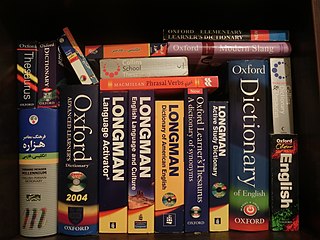
A dictionary, sometimes known as a wordbook, is a collection of words in one or more specific languages, often arranged alphabetically, which may include information on definitions, usage, etymologies, pronunciations, translation, etc. or a book of words in one language with their equivalents in another, sometimes known as a lexicon. It is a lexicographical reference that shows inter-relationships among the data.
JMdict is a large machine-readable multilingual Japanese dictionary. As of July 2018, it contained Japanese–English translations for over 180,000 entries, representing more than 205,000 unique headword–reading combinations. Because the dictionary files are free to use, they have been widely adopted on the Internet and are used in many computer and smartphone applications. This project is considered a standard Japanese–English reference on the Internet and is used by the Unihan Database and several other Japanese–English projects.
JWPce supports multiple file encodings and also supports Unicode both in files and on the clipboard. It does not provide facilities for vertical text, nor does it provide facilities to specify different fonts within a document. However, JWPce does allow the user to customize the fonts used to display text in the various parts of the editor. JWPce can also display kanji in a list you generate in a different color so that it colors either the kanji that the user does not know or that the user does know.
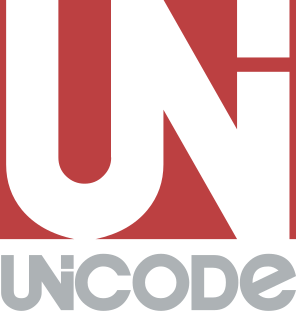
Unicode is a computing industry standard for the consistent encoding, representation, and handling of text expressed in most of the world's writing systems. The standard is maintained by the Unicode Consortium, and as of March 2019 the most recent version, Unicode 12.0, contains a repertoire of 137,993 characters covering 150 modern and historic scripts, as well as multiple symbol sets and emoji. The character repertoire of the Unicode Standard is synchronized with ISO/IEC 10646, and both are code-for-code identical.
A computer file is a computer resource for recording data discretely in a computer storage device. Just as words can be written to paper, so can information be written to a computer file. Files can be edited and transferred through the internet.
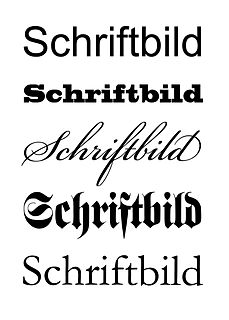
In metal typesetting, a font was a particular size, weight and style of a typeface. Each font was a matched set of type, one piece for each glyph, and a typeface consisting of a range of fonts that shared an overall design.
When importing from the clipboard, JWPce can detect the clipboard format automatically. That makes reading Japanese web pages much easier. JWPce also has the ability to provide a large amount of information on any kanji character, including meanings, on-yomi, kun-yomi, etc.

A web page is a document that is suitable to act as a web resource on the World Wide Web. When accessed by a web browser it may be displayed as a web page on a monitor or mobile device.
A key feature of JWPce is that it runs smoothly on Windows CE and Pocket PC platforms. This allows learners of Japanese to use a PDA as an electronic Japanese dictionary. The version for MS Windows on standard PCs also runs well under Wine in Unix-like environments. In case of problems with the compiled jwpce.exe, a special download for Wine is also available.

A Pocket PC, also known by Microsoft as a 'Windows Mobile Classic device', was a kind of personal digital assistant (PDA) that runs the Windows Mobile operating system. It has some of the abilities of modern desktop PCs.

Wine is a free and open-source compatibility layer that aims to allow computer programs developed for Microsoft Windows to run on Unix-like operating systems. Wine also provides a software library, known as Winelib, against which developers can compile Windows applications to help port them to Unix-like systems.

Unix is a family of multitasking, multiuser computer operating systems that derive from the original AT&T Unix, development starting in the 1970s at the Bell Labs research center by Ken Thompson, Dennis Ritchie, and others.
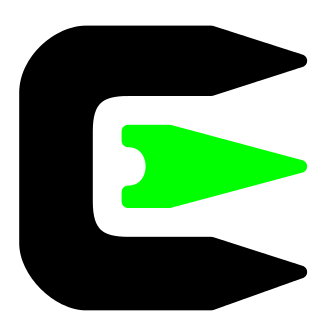
Cygwin is a POSIX-compatible environment that runs natively on Microsoft Windows. Its goal is to allow programs of Unix-like systems to be recompiled and run natively on Windows with minimal source code modifications by providing them with the same underlying POSIX API they would expect in those systems.
The editor war is the rivalry between users of the Emacs and vi text editors. The rivalry has become a lasting part of hacker culture and the free software community.

Emacs Lisp is a dialect of the Lisp programming language used as a scripting language by Emacs. It is used for implementing most of the editing functionality built into Emacs, the remainder being written in C, as is the Lisp interpreter. Emacs Lisp is also termed Elisp, although there is also an older, unrelated Lisp dialect with that name.

An integrated development environment (IDE) is a software application that provides comprehensive facilities to computer programmers for software development. An IDE normally consists of at least a source code editor, build automation tools, and a debugger. Some IDEs, such as NetBeans and Eclipse, contain the necessary compiler, interpreter, or both; others, such as SharpDevelop and Lazarus, do not.
Notepad is a simple text editor for Microsoft Windows and a basic text-editing program which enables computer users to create documents. It was first released as a mouse-based MS-DOS program in 1983, and has been included in all versions of Microsoft Windows since Windows 1.0 in 1985.
In human–computer interaction and user interface design, cut, copy and paste are related commands that offer an interprocess communication technique for transferring data through a computer's user interface. The cut command removes the selected data from its original position, while the copy command creates a duplicate; in both cases the selected data is kept in a temporary storage device called the clipboard. The data in the clipboard is later inserted in the position where the paste command is issued. The data is available to any application supporting the feature, thus allowing easy data transfer between applications.

Mojibake is the garbled text that is the result of text being decoded using an unintended character encoding. The result is a systematic replacement of symbols with completely unrelated ones, often from a different writing system.

Syntax highlighting is a feature of text editors that are used for programming, scripting, or markup languages, such as HTML. The feature displays text, especially source code, in different colors and fonts according to the category of terms. This feature facilitates writing in a structured language such as a programming language or a markup language as both structures and syntax errors are visually distinct. Highlighting does not affect the meaning of the text itself; it is intended only for human readers.
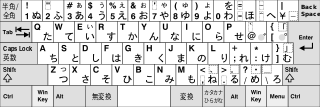
In relation to the Japanese language and computers many adaptation issues arise, some unique to Japanese and others common to languages which have a very large number of characters. The number of characters needed in order to write English is very small, and thus it is possible to use only one byte (28=256 possible values) to encode one English character. However, the number of characters in Japanese is much more than 256 and thus cannot be encoded using a single byte - Japanese is thus encoded using two or more bytes, in a so-called "double byte" or "multi-byte" encoding. Problems that arise relate to transliteration and romanization, character encoding, and input of Japanese text.
TextPad is a text editor for the Microsoft Windows family of operating systems. It is produced by Helios Software Solutions. It is currently in its eighth major version.

GNU Midnight Commander is a free cross-platform orthodox file manager. It was started by Miguel de Icaza in 1994 as a clone of the then-popular Norton Commander.
This article provides basic comparisons for common text editors. More feature details for text editors are available from the Category of text editor features and from the individual products' articles. This article may not be up-to-date or necessarily all-inclusive.
UMLet is an open-source Java-based UML tool designed for teaching the Unified Modeling Language and for quickly creating UML diagrams. It is a drawing tool rather than a modelling tool as there is no underlying dictionary or directory of reusable design objects. UMLet is distributed under the GNU General Public License.
The Rakuyōshū was a 1598 Japanese dictionary of kanji "Chinese characters" and compounds in three parts. The Jesuit Mission Press published it at Nagasaki along with other early Japanese language reference works, such as the 1603 Nippo Jisho Japanese–Portuguese dictionary. The Rakuyōshū, also known as the Rakuyoshu or Rakuyôshû, is notable as the first dictionary to separate kanji readings between Chinese loanword on and native Japanese kun.
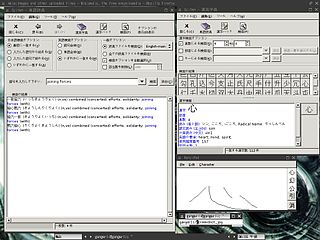
Gjiten is a free software dictionary application developed for Linux operating systems, using the GNOME development libraries. It functions primarily as a Japanese–English dictionary tool meant to search EDICT dictionary files, but it has other features such as hand-drawn kanji recognition. It was first published on December 25, 1999. Its current release is v2.6, available since October 28, 2006. The source code is downloadable from the developers' website.

Aquamacs is an Emacs text editor for macOS. It is based on GNU Emacs, currently tracking the GNU Emacs version 25.3 branch. Although GNU Emacs has had native UI support on macOS using the Cocoa API since version 23, Aquamacs modifies the user interface to conform with macOS standards in preference to Emacs standards.

GNU Emacs is the most popular and most ported Emacs text editor. It was created by GNU Project founder Richard Stallman. In common with other varieties of Emacs, GNU Emacs is extensible using a Turing complete programming language. GNU Emacs has been called "the most powerful text editor available today". With proper support from the underlying system, GNU Emacs is able to display files in multiple character sets, and has been able to simultaneously display most human languages since at least 1999. Throughout its history, GNU Emacs has been a central component of the GNU project, and a flagship of the free software movement. GNU Emacs is sometimes abbreviated as GNUMACS, especially to differentiate it from other EMACS variants. The tag line for GNU Emacs is "the extensible self-documenting text editor".
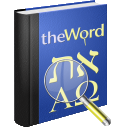
The Word is a free Bible study software application for Microsoft Windows. It was first released in 2003 by its developer, Costas Stergiou. Though created mainly as a proof of concept Bible viewer, The Word has developed into a comprehensive and powerful Bible study application, offering not only Bibles, but also commentaries, dictionaries, general books, maps, etc. The Word also provides advanced, full library search capabilities. The Word is an internationalised application, featuring support for Bibles in many different languages, and user-interface localizations.

GoldenDict is an open-source dictionary program that gives translations of words and phrases for different languages. It allows the use of several popular dictionary file formats simultaneously and without conversion.




















